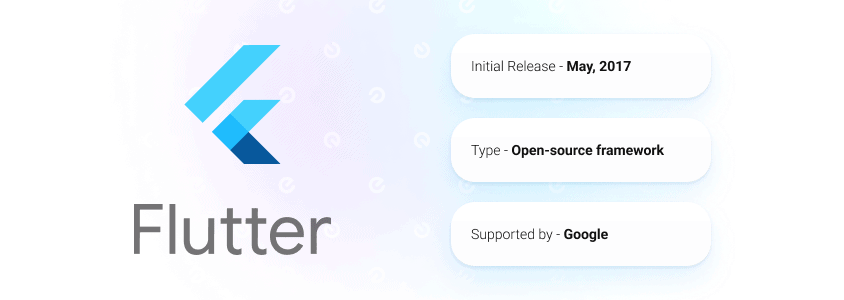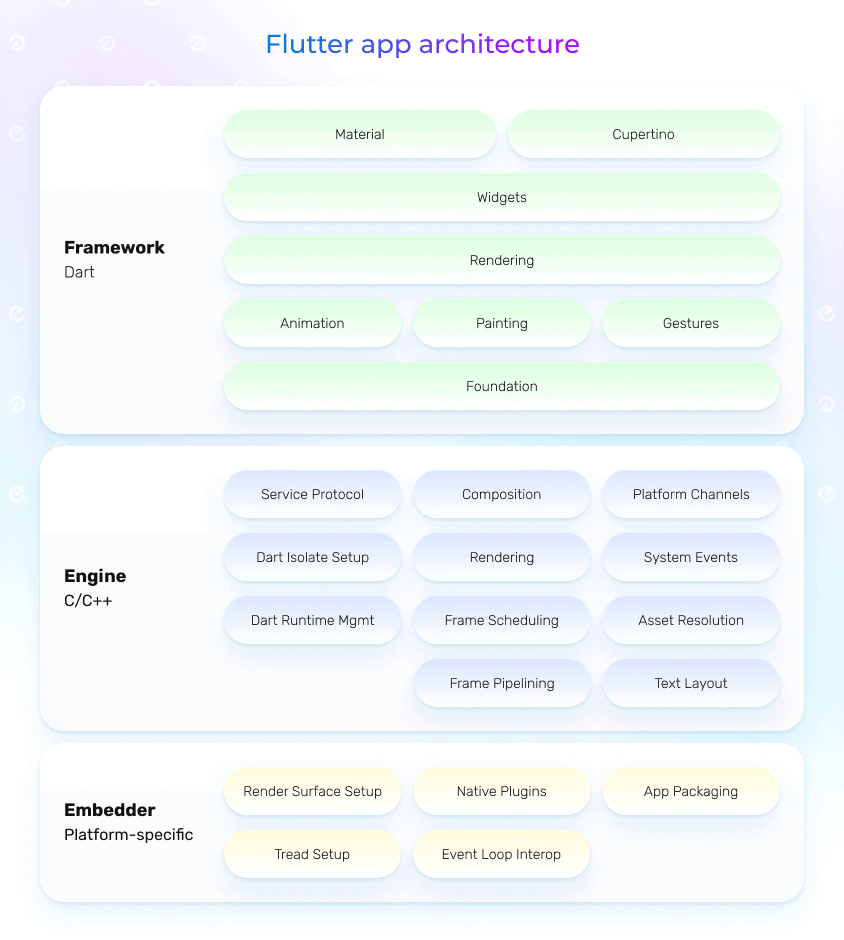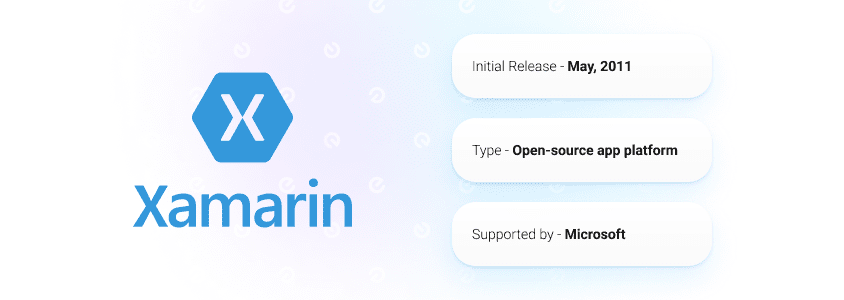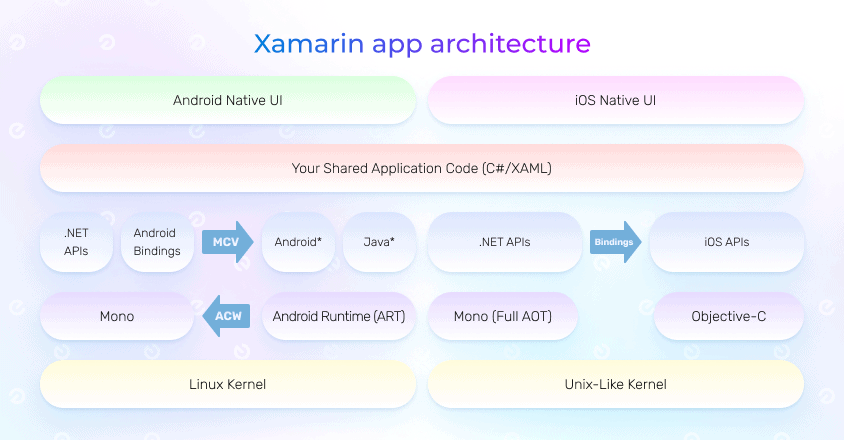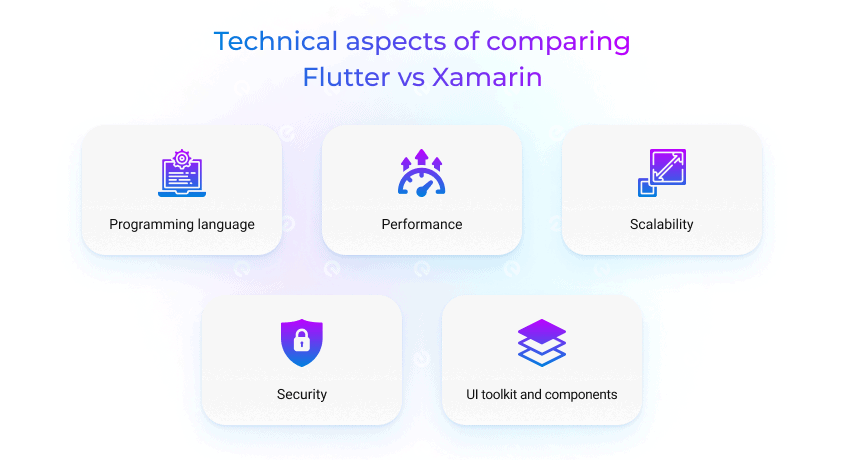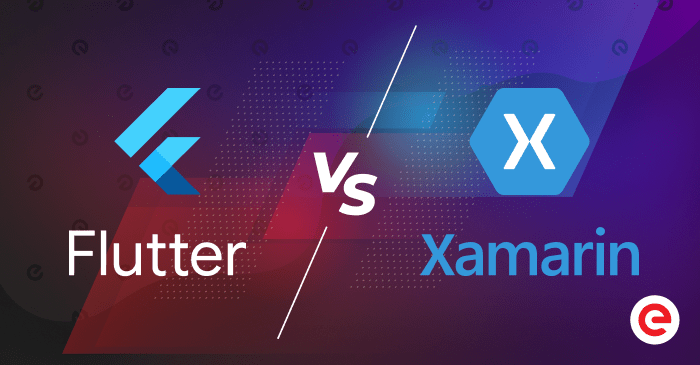
Updated: July 4, 2024
Published: November 4, 2022
Planning to implement a cross-platform application? But how to make the final technology choice? It is only possible by comparing one and other technologies with the main goal of finding the right one. Learning the latest market trends, we’ve decided to comprehensively compare Flutter vs Xamarin. Read the article to discover some decisive aspects of simplifying your choice.
List of the Content
- Flutter vs Xamarin: market tendencies
- What is Flutter used for?
- What is Xamarin used for?
- Flutter vs Xamarin: technical aspects
- Xamarin vs Flutter: business aspects
- Flutter vs Xamarin: what’s better for app development?
- Conclusion
FLUTTER VS XAMARIN: MARKET TENDENCIES
The technology stack has always been a decisive factor in delivering functional and beautiful apps. With the fast-evolving market, the tech variety is increasing significantly. Thus, some teams can even face choice difficulties considering one or another technology. Developers have received more and more good alternatives. At the same time, they aim to adopt balanced and flexible approaches. So the main question is how to choose the best option regarding your project needs.
Following the latest market tendencies, we can see how popular cross-platform app development has become. It has brought the unique opportunity to build apps for different platforms from a single codebase. Developers find it rather effective and productive to build, test and deploy required solutions. Great functionality and explicit process adoption make cross-platform frameworks highly demanded in many projects. The popularity is also supported by other distinct benefits valued among developers and businesses.
Looking through the known cross-platform technologies, we drew attention to such representatives as Flutter and Xamarin. It’s rather impressive how these technologies have evolved over recent years. Moreover, they turned into progressive solutions to stay competitive and meet various project needs. In this article, we’ll go with a detailed comparison of Flutter vs Xamarin to find core specifications and how they became so popular among developers and businesses.
Cross-platform development supports progressive solutions and streamlines the delivery process. It might be considered new to the market, but it has greatly advanced the development opportunities. For less than a decade, cross-platform approaches have transformed app development and brought it to completely new levels. Continuing with the Flutter vs Xamarin comparison, it’s worth saying that Xamarin was among the first on the market. Xamarin started as an independent software development company in 2011 that introduced a number of cross-platform solutions like Zamarin.Android, Zamarin.iOS, etc. In 2016, Xamarin was acquired by Microsoft to become its known subsidiary. Currently, Zamarin is an open-source platform for building iOS, Android and web applications with .NET. It’s a mature technology with great opportunities to deploy applications to various platforms.
Flutter is a newer technology, as it was released in 2017. However, this open-source framework powered by Google has gone a long way and managed to become even more popular than its earlier competitor. If we compare Flutter vs Xamarin, both of them have gained strong market positions and chosen to implement many great projects. At the same time, Google trends help to show how the interest in these technologies has changed over the years.
If the interest in Xamarin stays relatively stable, Flutter constantly grows in popularity. Actually, it’s easier to explain this tendency when we focus more detail on each technology. It’s worth learning how each representative evolves and what they can offer for different projects.
How to approach cross-platform app development?
Find more details on development approaches and best practices, including the list of top hybrid frameworks.
WHAT IS FLUTTER USED FOR?
When the team chooses the tech stack, it’s always important to check the technology functionality as well as its advancement over time. It goes without saying that the technology market evolves at a rapid pace. And some representatives, once at the top, could easily lose positions if not constantly developing.
Flutter is an excellent example of how technologies need to be supported and developed. In 2015, Google unveiled a new technology, Flutter, primarily developed for Android app development. Their main goal remained to deliver a solution that could support Android and iOS app development. At the end of 2018, the team released the first stable version of Flutter with iOS and Android support. They continued to put in lots of effort and investments to advance the framework. It has quickly gained popularity among developers and has been adopted in different projects. It’s only worth mentioning the number of applications built with Flutter reaching the point of 500k at present.
Besides, they have gone even far with Flutter advancements as they introduced web, desktop and embedded platform support. It helps to make this framework one of the fastly-evolving cross-platform solutions. They adopt the best practices and keep it open-source and easily accessible to the community. Currently, Flutter can be applied for:
- Mobile app development
- Web app development
- Desktop app development
- Embedded app development
Choosing this framework brings all the advantages of cross-platform development approaches. Flutter developers acknowledge great functionality, fast development, high performance, accessible documentation, strong community support, etc. Also, the introduced system architecture is another distinct advantage that differentiates Flutter. The extensible and layered system allows working with independent libraries, though, depending on the underlining layers. At the same time, parts of framework layers are created to be replaceable and even remain optional if required.
It’s worth saying that the same UI and business logic for any platform are handled by the powerful language – Dart. As for developers’ convenience, it’s easy to convert Dart code into native one for required platforms, including web, mobile or desktop. Working with a single codebase helps to increase productivity and streamline the workflow. Besides, developers are provided with lots of helpful tools for testing, debugging, performance and other tasks.
Flutter has gained tremendous support on the market. It’s adopted with projects of different complexity and various specifications. Both large businesses and small teams find it efficient to choose Flutter to deliver beautiful and functional apps. It contains everything to support the productive workflow and build reasonable solutions. Flutter opens new opportunities for development teams and businesses. The potential of this framework has definitely impressed the market, and it continues expanding. Considering the fact that Flutter has been on the market for less than five years, they have achieved considerable success. Moreover, they keep strengthening their position by delivering exceptional functionality to build full-fledged solutions for any platform. This cross-platform framework became a decent competitor to other more mature technologies, including Xamarin.
Would you like to find more on Flutter use cases?
We recommend checking our latest article on Flutter app examples to learn more about development with Flutter and how to use it to the advantage of your project.
WHAT IS XAMARIN USED FOR?
Thinking of leveraging cross-platform app development, many teams would also refer to this market representative. Xamarin is known as a mature solution used for many projects. Comparing Xamarin vs Flutter, it has been longer on the market and gained considerable popularity among developers.
This platform has its beginning as a software company specializing in cross-platform implementations. Back in 2011, they worked on leveraging Mono for Android and iOS devices (now known as Xamarin.Android and Xamarin.iOS). That had turned into successful products, so Microsoft acquired Xamarin to extend .NET developer platform in 2016. Since then, Xamarin has gone through a number of advancements and transformations. At present, Xamarin presents a variety of libraries and tools to create apps with .NET. The great advantage relies on the ability to create a C#-shared codebase to use Xamarin on different platforms. Teams can use this open-source, cross-platform technology for:
- iOS and Android app development
- Windows app development
- macOS, watchOS and tvOS app development
It’s obvious that this technology often becomes a choice for teams that prefer developing with .NET. In its turn, Xamarin added a robust base framework, platform-specific libraries, modern IDE, extensible markup language, editor extensions, etc. The offered tools and features allow developers to compile great apps supporting native-like performance.
Moreover, they have access to every available tool within .NET developer platform.
Another distinct benefit differentiating Xamarin from Flutter is that the entire application will be written in C#. The team can leverage C# to implement business logic, support data access, as well as use it for API access. Xamarin enables developers to reach the goal of developing apps with C# and Visual Studio while sharing the written code across multiple platforms.
The important aspect is that Xamarin entered the market a bit earlier than other cross-platform representatives. Once started as a close project, Microsoft open-sourced Xamarin and bundled it within the integrated development environment. That was an excellent decision as the new open-source, cross-platform solution has fastly gained in popularity among developers and businesses. The opportunity to build apps for multiple platforms using Xamarin and .NET has formed a supportive and active community.
Xamarin is often chosen for good functionality, native-like performance, great UI, comprehensive documentation, integration options, etc. Businesses successfully leveraged this cross-platform app platform for projects of different complexity, including enterprise ones. Some known use cases include the Xamarin projects developed by UPS, Alaska Airlines, the American Cancer Society and others.
Even though Xamarin has everything required for cross-platform development, the latest announcements were quite surprising for many teams. All the Xamarin projects will have to undergo the transaction to .NET MAUI through May 1, 2024. Microsoft has announced this cross-platform framework as the Xamarin successor. For now, teams have no issues using Xamarin, but transaction to .NET 6 and above is highly encouraged. Xamarin SDKs will be supported during the announced term with the final version of iOS 16 and Android 13.
FLUTTER VS XAMARIN: TECHNICAL ASPECTS TO COMPARE
Having some background on each technology, we’ll continue with a more detailed comparison of Flutter vs Xamarin. Teams could set up requirements focusing on many aspects. But any outlined requirements will be easily referred to either technical or business specifications. So we’ve decided to take these two groups of requirements to remain more specific and go into detail for better understanding. Let’s start with core technical aspects that can make a difference in making a final choice for Xamarin vs Flutter.
- Programming language
The biggest difference between Flutter vs Xamarin is the language used for app development. Flutter applications are built with a modern and powerful programming language, Dart. It’s a client-optimized language to deliver beautiful, fast and functional solutions on any platform. In comparison, Xamarin applications are implemented with C# with Visual Studio. Besides, Xamarin is built upon the .NET legacy, which makes it attractive for developers familiar with .NET development.
- Performance
That‘s one of the distinct characteristics to make cross-platform technologies so popular on the market. There’s no more necessity to compromise user experience due to various platform compatibility. Teams have gained the possibility to deliver native-like performance while implementing cross-platform development. In the light of comparing Flutter vs Xamarin performance, it’s worth saying that one technology will be better to address this specification. Due to the implemented system architecture, Flutter can provide really high performance. Xamarin remains slower as it always needs to translate the tree of native controls.
- Scalability
Flutter is not only faster but also more scalable than Xamarin. It’s quicker and simpler to add new features and accommodate an increasing number of users. That’s the unique Flutter architecture that makes it highly scalable and extensible. In its turn, Xamarin relies upon binding SDKs and APIs of different platforms. The new functionality will be presented after plugging it into the operating system.
- Security
It has always been a significant concern to implement safe coding and secure applications. The chosen tech stack is the main option to address these needs. Both Flutter and Xamarin are considered highly secure technologies to consider. Teams have access to all the required tools to provide full protection, minimize risks and prevent vulnerabilities. The other thing to consider is constant updates. In the case of Flutter vs Xamarin security, developers need to take into the recent announcement of Xamarin support determination and its transition to .NET MAUI through May 2024.
- UI toolkit and components
The great app design helps to connect with users, build trust and convenience them to stay with your product. As a result, it becomes really important to introduce a beautiful and functional application. Available UI toolkits are always worth the special attention of the development team. Flutter is a definite leader of the market, as it goes with extensive collections of UI components, including Cupertino and Material. The Flutter UI widgets embrace several categories, including structural, visual, interactive and platform ones. As for Xamarin, it also presents its own UI toolkit known as Xamarin.Forms. However, we need to take into account Microsoft’s evolution of Xamarin.Forms into .NET MAUI. It is a great step forward, though some functionality still remains in preview.
Have additional questions on Flutter vs Xamarin functionality?
Existek’s team is at your assistance. We’ll gladly share our decade-long experience in software development to choose the best suitable solution to cover your needs.
XAMARIN VS FLUTTER: BUSINESS ASPECTS TO COMPARE
In fact, differentiating technical aspects is only halfway to choosing the technology. Sometimes, details related to the business points might even have a stronger impact on the final choice. In the case of Flutter vs Xamarin, business aspects definitely take the bigger share. Let’s go into more detail about how to compare these technologies regarding business needs.
- Market popularity
One of the efficient ways to compare competitors is to check their popularity in the market. Great technologies are faster recognized among developers and widely used throughout projects. It’s always helpful to follow best market practices and stay up to date with the latest trends. It doesn’t need to take long for good technology to enter the market, as well as lose positions if not constantly developed. In light of Flutter vs Xamarin 2022 market positions, the first solution has considerably gained in popularity and is more loved by developers. As for the current market situation, Flutter is definitely beating Xamarin regarding wider adoption within cross-platform development.
- Technology stability
The necessity to ensure technology stability is as important as looking for security or performance advantages. Creating applications with technologies lacking functionality, documentation, or regular updates is always hard. The team’s responsibility is to make their choice towards mature and advancing solutions. Market tendencies could become good indicators there. Even though Xamarin is a mature technology, it’s experienced some downward tendencies over the recent time. With the appearance of new competitors like Flutter and React Native, it becomes harder to compete. Somehow, that also explains Microsoft’s decision to end supporting Xamarin with its transition to .NET MAUI through May 2024. In its turn, Flutter is a relatively newer technology though more stable to meet the rising market demand and developer needs.
Would you like to compare Flutter with .NET MAUI?
Find a detailed comparison of these technologies and how to deliver functional multi-platform solutions with them.
- Development process
App success can also be measured by how fast and efficiently developers can deliver the required solutions. The teams are looking for flexible approaches to streamline the process and save resources. Developers favour working with technologies that are fast to learn, easy to use and simple to adopt. At its core, any cross-platform technology aims to simplify the process as developers deal with a shared codebase from the beginning. In the case of the Flutter vs Xamarin comparison, it’s worth saying that Flutter is more efficient for the developers’ needs.
- Cost-efficiency
One of the common reasons to consider Xamarin or Flutter for the next project is the cost-efficiency of cross-platform app development. Teams received the opportunity to considerably shorten the app delivery time as well as development expenses. However, comparing Flutter vs Xamarin salaries in the US, you can notice that the services of Xamarin developers cost more. The average salary of Flutter developers in the US is $84,676, and $106.114 for Xamarin ones. This tendency can be attributed to the fact that there is greater availability of Flutter specialists on the market. At the same time, many Xamarin developers have already started transitions to other technologies due to the latest announcements.
- Community support
It won’t be surprising that community support plays an important role in advancing any tech solution. We can see how technologies like Flutter and Xamarin, even powered by Google and Microsoft, are introduced as open-source products. Active and supportive communities allow them to build an extensive knowledge base. Besides, they become a powerful engine to further advancements. Access to tools and resources helps expand expertise and share valuable coding tips and development advice. Currently, the Flutter community is twice larger as it numbers more than 2M developers compared to 1.4M Xamarin specialists.
FLUTTER VS XAMARIN: WHAT’S BETTER FOR APP DEVELOPMENT?
As long as we’ve gathered all the necessary aspects of making the tech choice, it’s time to proceed with the main question. Which is better: Flutter vs Xamarin? It isn’t easy to give the answer at once as there are many successful projects implemented with one or another technology. In their turn, Flutter and Xamarin teams are doing their best to meet the market demand and developers’ needs.
The first thing to remember is that there can’t be a wrong choice in general. Along with the carefully defined specifications and learnt technology properties, every team has an opportunity to make informed decisions. There will always be a way to build an application with any cross-platform solution. The main thing is just to find out whether it is the best available alternative. It’s worth saying that the choice depends on the criteria the team sets, whether Flutter is better than Xamarin or Xamarin is better than Flutter.
| Flutter | Xamarin | |
| Type | Open-source framework | Open-source app platform |
| Introduced | 2018 | 2011 |
| Programming language | Dart | C# |
| Performance | High | Moderate |
| Tools and functionality | A great variety of required tooling | A large set of tools, including ones within the .NET developer platform |
| Documentation | Comprehensive and accessible | Clear and accessible |
| UI components | Built-in customized UI components | Native UI components |
| Community | Large and growing | Good-sized but slowly reducing |
| Developers’ availability | 2M+ specialists | 1.4M specialists |
| Community support | Strong | Limited |
| Use cases | BMW, Alibaba Group, GooglePay, eBay, Nubank, Hamilton, etc. | UPS, HCL, American Cancer Society, Alaska Airlines, FreshDirect, etc. |
| Future perspectives | Remain on the market and continue to extend | Transition to .NET MAUI through May 2024 |
Comparing Flutter vs Xamarin, we deal with mature technologies that have gained recognition on the market. Both solutions provide an extensive set of functionalities to deliver full-fledged software products. At the same time, one representative seems to be a definite winner in this tough competition.
Flutter has definitely proved its success in the market with extensive functionality, high performance, a smoother development process and active community support. At some point, Xamarin reached the stage of further advancement only within its successor .NET MAUI. On the one hand, it’s good news, but on the other, it is always challenging to go through the transition process. So at present, choosing Flutter, especially for new projects, will be a better decision. Besides good functionality, the team has to approach the technology choice from a long-term perspective.
Making the Flutter vs Xamarin comparison, we can see how important to stay up-to-date and follow the market tendencies. Good market practices and experiences shared by others present valuable insights for making the right choice.
Where to find a professional Flutter team?
Our company provides Flutter app development services to address various needs and requirements. Feel free to contact us for additional information or assistance in building valuable market solutions.
CONCLUSION
It’s always important to learn how teams can approach the technology choice based on the specific use case, set goals and outlined requirements. With the fast advancement of cross-platform app development, businesses have received exceptional solutions to address numerous needs at once. What’s only worth mentioning is the opportunity to deliver applications for different platforms from a single codebase.
Of course, the right technology will vary depending on the decisive factors and characteristics of each project. Though in the light of comparing Flutter vs Xamarin, we find many winning points to consider Flutter as a more stable, advanced and promising solution for building beautiful and functional apps.
Have you decided to create a cross-platform application?
Feel free to contact Existek. Our team knows how to turn your ideas into full-fledged solutions with the required functionality to deliver services and attract new customers.
Frequently asked questions
What are the top cross-platform technologies?
According to the latest statistics, the top market positions belong to such cross-platform solutions as:
Flutter
React Native
Xamarin
How to select the right technology for cross-platform app development?
The technology adoption always varies from project to project. Therefore, comprehensive analysis and careful planning are the right approaches to addressing the outlined needs. That won’t be hard to choose the suitable technology provided the team knows its goals through set functional and non-functional requirements.
What are the decisive aspects of making the Flutter vs Xamarin choice?
As for any other technology decision, the team has to draw attention to the following characteristics:
Available tools and functionality
Performance and scalability
Technology stability
Community support
Development process efficiency
Flutter vs Xamarin: what’s better?
Considering all the mentioned details and gathered aspects, we can easily conclude that Flutter is obviously beating the competition. Over a relatively short period of time, it has proved to be a flexible and advancing technology that doesn’t seem to lose its position in the nearest future. As for Xamarin, it goes through tougher times, and everyone is eager to see if it manages to go through this evolution successfully.



